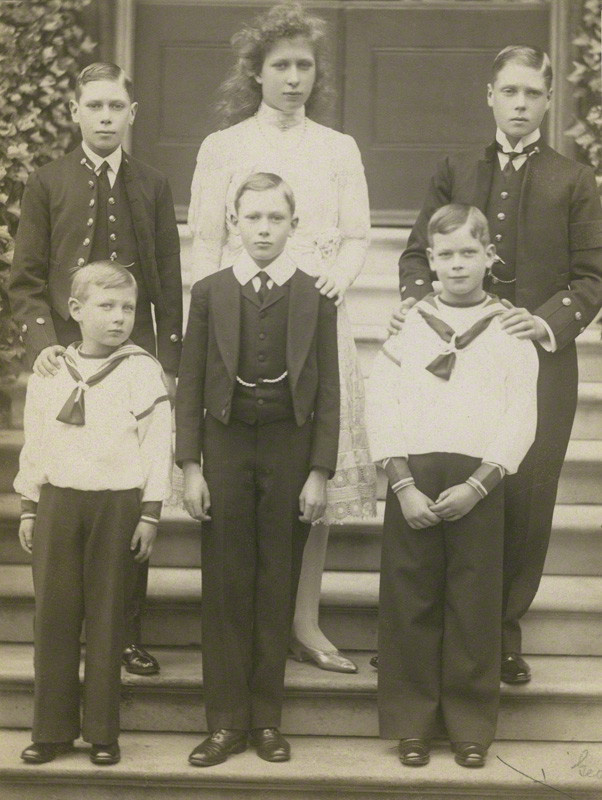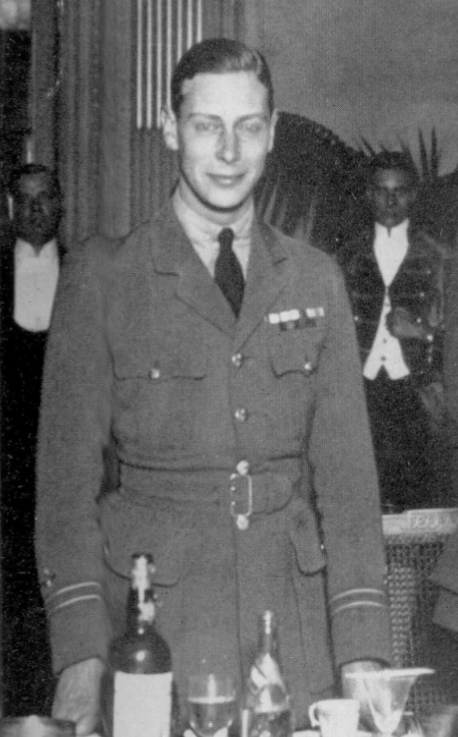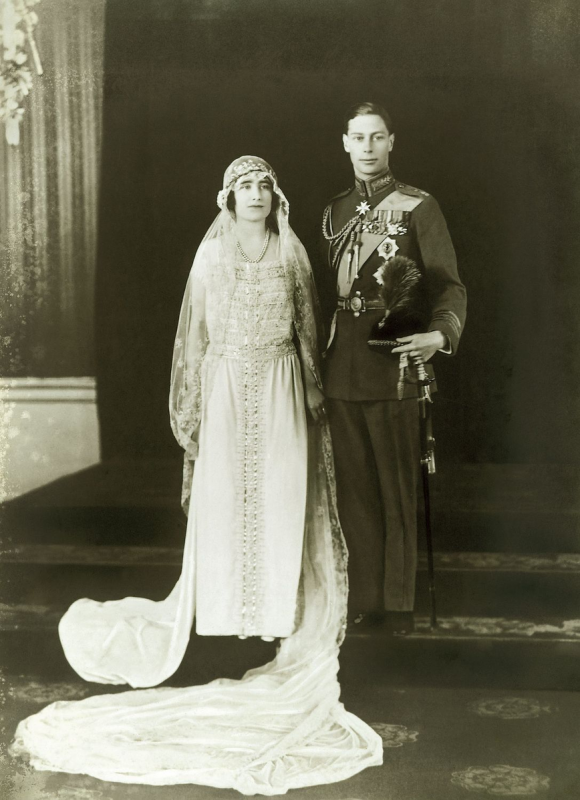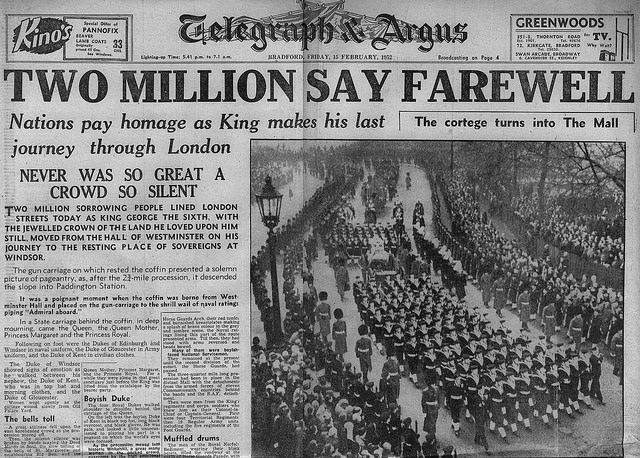Early Life
Albert Frederick Arthur George was born as the second son to the then Prince George, Duke of York and Mary, Duchess of York on 14 December 1895 at York Cottage on the Sandringham Estate. He was born during the reign of Queen Victoria – his great-grandmother and was fourth in line to the throne after his grandfather, father, and older brother, Prince Edward.
As the young prince was born on the 34th anniversary of the death of his great-grandfather, Prince Albert, his grandfather, The Prince of Wales was concerned about how his mother would take the news. He decided to write to his son to suggest that they use the name ‘Albert’ for the new prince, as it would mean a lot to Victoria. Victoria would later write about how pleased she was to the Duchess of York saying, “I am all impatience to see the new one, born on such a sad day but rather more dear to me, especially as he will be called by that dear name which is a byword for all that is great and good.”
On 17 February 1896, His Highness Prince Albert Frederick Arthur George was christened at St. Mary Magdalene’s Church in Sandringham, Norfolk, by John Sheepshanks, Bishop of Norwich. His godparents were his paternal great-grandmother, Queen Victoria, maternal great-aunt and great-uncle, the Grand Duke and Grand Duchess of Mecklenburg, paternal great-aunt, Empress Frederick (previously known as Victoria, Princess Royal), paternal great-uncle, Crown Prince Frederick of Denmark (later King Frederick VIII of Denmark), paternal aunt, Louise, Princess Royal and Duchess of Fife,maternal uncle, Prince Adolphus of Teck, and paternal great-uncle, Prince Arthur, Duke of Connaught and Strathearn.
Three years later, Queen Victoria issued Letters Patent granting the children of the Duke and Duchess of York, the style of Royal Highness. Thus, he became His Royal Highness, Prince Albert of York on 28 May 1898.
Officially known as Prince Albert of York, the young prince was affectionately known simply as ‘Bertie’ to his family. He was known to be shy, easily frightened, and suffered from a speech impediment.

He was raised in York Cottage and York House, St James’s Palace, alongside his four brothers and one sister. He was often ill as a child and had to wear corrective splints on his legs due to his suffering of “knock knee”, where a person’s two knees angle in and touch one another when straightened.
Queen Victoria passed away on 22 January 1901, and his grandfather ascended the throne as King Edward VII. Albert moved up to third in line for the throne, but as the second son of the Prince of Wales, he never expected to become monarch.
Education
Albert was privately educated before he enrolled at the Royal Naval College, Osborne, as a cadet in 1909. Two years later, he would move on to the Royal Naval College, Dartmouth, despite coming in the bottom of his class in the final examination. A year before his progression to the Royal Naval College, Dartmouth, his grandfather passed away, and his father became King George V. His elder brother was invested as Prince of Wales, and he became second in line to the throne.
Prince Albert would train and serve on the HMS Cumberland in the West Indies and the eastern coast of Canada during the first six months of 1913. He would further serve on the HMS Collingwood in the Mediterranean Sea during the last few months of the year as a midshipman.
October of 1919 found Albert in Cambridge at Trinity College, where he studied history, civics, and economics.
Service
After his commission, he began his service in World War I in 1914. He saw combat during the Battle of Jutland in 1916. He would not see any further action due to health issues. In November of 1917, he underwent surgery for a stomach ulcer.

He was appointed Officer in Charge of Boys at the Royal Naval Air Service’s training location in Cranwell in February of 1918. The Royal Air Force was established two months later, and it was at this point that Albert switched to the Royal Air Force. He would be appointed as Officer Commanding Number 4 Squadron of the Boys’ Wing at Cranwell in August of that year. His Royal Highness then reported to the Royal Air Force’s Cadet School at St Leonards-on-Sea. There he trained for two weeks and took command of a squadron in the Cadet Wing.
Serving with the Independent Air Force, he was stationed in Nancy, France, during the end of the First World War. After the Independent Air Force was disbanded in November of 1918, he remained in Europe for two months as a staff officer. He returned to Britain in early 1919. He became the first member of the British royal family to become qualified as a pilot on 31 July. The next day he was promoted to squadron leader.
Royal Duties
On 4 June 1920, he was named Duke of York, Earl of Inverness, and Baron Killarney. He began taking on more royal duties at this time. He would travel and visit coal mines, rail yards, and factories, gaining the nickname “Industrial Prince”. His elder brother, Edward, Prince of Wales always overshadowed Albert. This was due to the latter’s shy nature and stammer, which caused him to be very uncomfortable speaking in public.
Later, he would become President of the Industrial Welfare Society, after developing an interest in working conditions. Further, he would host a series of summer camps from 1921 to 1939 that brought together boys from different societal backgrounds.
His Royal Highness would deliver the closing speech at the British Empire Exhibition on 31 October 1925. Plagued by his speech impediment, he struggled to give this speech, and as a result, he began to see a speech therapist, Lionel Logue. Logue worked with Albert on his breathing, and he would practise his breathing exercises with his wife, the Duchess of York. His speaking ability improved, and on a tour of the empire in 1927, he delivered a speech at the opening of the new Parliament House in Canberra, Australia.
Prince Albert’s father, King George V passed away on 20 January 1936, and his elder brother, the Prince of Wales ascended the throne as King Edward VIII. Since Edward was unmarried and had no children, Albert was the heir-presumptive to the British throne.
Family Life
In 1920, Albert met Lady Elizabeth Bowes-Lyon for the first time since their childhood. He fell in love with the youngest daughter of the Earl and Countess of Strathmore and Kinghorne and became determined to marry her. Lady Elizabeth, reluctant to marry into the royal family, rejected his proposals twice before finally accepting on Albert’s third attempt. They were married at Westminster Abbey on 26 April 1923. Unexpectedly, the new Duchess of York laid her wedding bouquet at the Tomb of the Unknown Warrior, in memory of her late brother, Fergus. After the wedding, the couple took up residence at 145 Piccadilly in London.

The Duke and Duchess of York toured Kenya, Uganda, and Sudan from December 1924 to April 1925.
Always physically active and a lover of tennis, he played at Wimbledon in the Men’s Doubles with Louis Greig but lost in the first round in 1926.
On 21 April 1926, their first child, Princess Elizabeth (now Queen Elizabeth II) was born. She was followed by a younger sister; Princess Margaret was born on 21 August 1930. Both he and the Duchess of York were known to be close and loving with their two children. Both girls were educated at home, under the supervision of their mother and their governess. Things would soon change for the family as King Edward VIII would abdicate so that he could marry his American love, the twice-divorced Wallis Simpson.
Life as King
After his older brother’s abdication, Albert reluctantly became king. He chose his regal name as King George VI. Regarding his new position as king, he wrote in his diary after visiting his mother, Queen Mary, “When I told her what had happened, I broke down and sobbed like a child.”
On 11 December 1936, Edward officially abdicated. On that day, the Irish Free State’s parliament removed all direct mention of the monarch in their constitution, and a day later, they passed the External Relations Act. These two actions basically made the Irish Free State a republic, yet retained its links to the Commonwealth.

One of the first acts of King George VI was to confer the title of “His Royal Highness The Duke of Windsor” upon his brother. However, he issued Letters Patent that stated that any wife or future children were barred from using royal styles. He would also have to buy both Sandringham House and Balmoral Castle from his elder brother, as they were private properties and did not pass to George VI upon his ascension to the throne.
His coronation took place on 12 May 1937, which was the date that had been intended as Edward’s coronation. His mother, Queen Mary, breaking with tradition, attended the coronation in a show of support for her second son.
After the coronation, the King and Queen travelled to the United States and Canada in 1939. He was the first Canadian sovereign to visit the North American country. They visited the United States on the invitation of President Franklin D. Roosevelt, where the President and King forged a strong bond. It was not long after their return to Britain that the country declared war on Germany and entered World War Two.
Both the King and Queen were known to travel around the country to bolster morale during the war. Famously, he and his wife chose to stay in London during the German bombing raids. While they officially stayed in Buckingham Palace, many evenings they spent the night at Windsor Castle. The King and Queen were very close to death when two German bombs exploded in a Buckingham Palace courtyard on 13 September. The Queen famously said, “I am glad we have been bombed. It makes me feel we can look the East End in the face.” George VI visited the British forces abroad in locations such as North Africa, Malta, and Normandy.
Lord Hailsham, a senior politician, suggested that Princess Elizabeth and Princess Margaret be evacuated to Canada. However, their mother would hear nothing of it. She said, “The children won’t go without me. I won’t leave without the King. And the King will never leave.”
After the war had ended in 1945, crowds chanted for His Majesty in front of Buckingham during the celebrations. The royal family, alongside Winston Churchill, appeared on the balcony in front of the public that had gathered.
During his reign, the British Empire became the Commonwealth of Nations. George VI would give up the title of Emperor of India when British India became India and Pakistan. He would cease to be King of India in 1950 when it became a republic within the Commonwealth. He remained as King of Pakistan until his death.
On 9 July 1947, his eldest daughter, Princess Elizabeth announced her engagement to Prince Philip of Greece and Denmark. They married on 20 November 1947 at Westminster Abbey.
Final Years
The King’s health began declining after the end of the Second World War. Always a heavy smoker, George was diagnosed with lung cancer, arteriosclerosis, and Buerger’s disease. He was due to tour Australia and New Zealand, but in March 1949, the plans were put on hold after he suffered an arterial blockage in his right leg. Princess Elizabeth, heir presumptive to the throne, began to take on more royal duties on behalf of her father, including the planned tour of Australia and New Zealand.
His Majesty had recovered enough that, in May 1951, he was able to open the Festival of Britain. However, by 23 September, he had to have his left lung removed after a malignant tumour had been discovered. In November, the Lord Chancellor, Lord Simonds had to read the King’s speech for him at the State Opening of Parliament. He had to record his Christmas message in sections, which were later edited together before they were broadcast to the public.
Despite the advice from doctors and those close to him, he insisted on being at the London Airport on 31 January 1952 to see Princess Elizabeth and Prince Philip off on their tour of Australia. They would be travelling to Kenya first, before going on to the island nation.
On 6 February, King George VI passed away in his sleep from a coronary thrombosis at Sandringham House at just 56-years-old. His eldest daughter, who he had just seen off on a royal tour, was now Queen Elizabeth II. She would go on to become the longest-reigning British monarch, surpassing Queen Victoria in 2015.

For two days, his coffin laid in St Mary Magdalene Church, Sandringham on 9 February to the 10th. His coffin laid in state at Westminster Hall beginning on 11 February. His funeral took place on 15 February at St. George’s Chapel, Windsor Castle, where he was interred. His body was transferred to the King George VI Memorial Chapel inside of St George’s Chapel on 26 March 1969.

